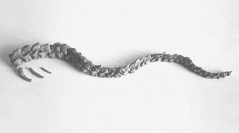

 Comptes Rendus Palevol
4 (1-2) - Pages 79-93
Comptes Rendus Palevol
4 (1-2) - Pages 79-93The Tonnay-Charente area (Charente-Maritime, southwestern France) contains several sand and clay exploitations of Uppermost Albian and Lower Cenomanian ages. These sediments have been deposited in a coastal area where plant remains, amber, and aquatic or terrestrial vertebrates were trapped. The two last quarries that could be studied, Puy-Puy and Les Renardières, are true Lagerstätten, the first one for the abundance and the diversity of meso- and macroremains of plants (pollen, cuticles, lignite), especially angiosperms, the second one for the vertebrate microremains, consisting of about forty taxa, with selachians and actinopterygians, different reptiles (crocodilians, dinosaurs, ophidians, turtles) and one mammal. This paper describes the sedimentary and palaeoenvironmental settings of the Albian–Cenomanian series from Puy-Puy and Les Renardières and illustrates the most outstanding taxa of vertebrates and plants collected until today.
Angiosperms, Frenelopsis, Selachians, reptiles, mammals, Albian–Cenomanian, Charente-Maritime, southwestern France